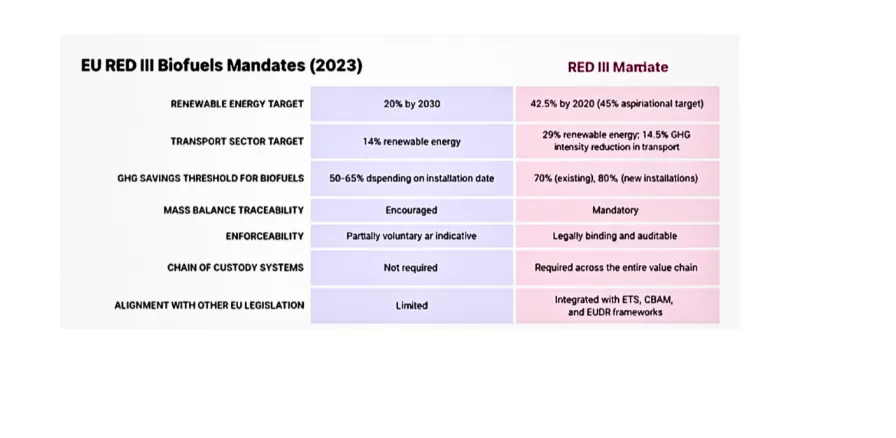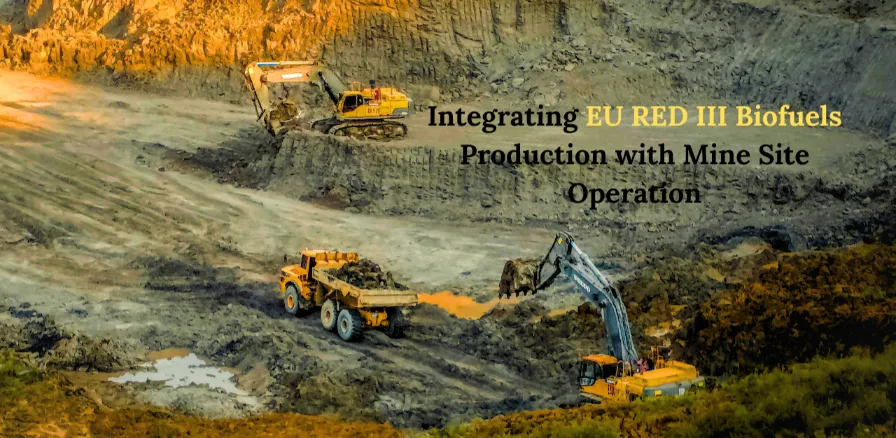Fuelling the Future: How EU RED III Biofuels are Greening the Mining Ecosystem
The worldwide mining industry, always seen through the sneak peek of heavy machinery and significant environmental impact, is now profoundly transform. As global demands for sustainability deepen, a new paradigm is emerging: the Green Mining Ecosystem. Behind This innovative approach to energy, particularly the integration of on-site production of EU RED III biofuels, facilitating a truly sustainable future.
The mandate for Green Mining
Mining operations are energy conservation system, relying mainly primarly on fossil fuels from excavation and transportation to processing and site rehabilitation. This dependence contributes significantly to greenhouse gas emissions and high operational costs, making the shift to greener alternatives not just an environmental requirement but also an economicrequirement. The Green Mining Ecosystem imagines acomprehensive approach where environmental directions, resource efficiency, and renewable energy are weaved into every stage of the mining lifecycle.

What are EU RED III Biofuels and Why Are They Key?
The European Union’s Renewable Energy Directive (RED III) is a legislation that drives the transition to cleaner energy. EU RED III biofuels are liquid or gaseous fuels for transport produced from biomass that meet strict with sustainability and greenhouse gas saving criteria set out in the directive. These criteria ensure that the biofuels genuinely contribute to decarbonization without causing adverse impacts like deforestation or food insecurity.
For the mining sector, embracing EU RED III biofuels means:
- Significant Emissions Reduction: Replacing diesel and other fossil fuels with EU RED III biofuels directly cuts down emissions from mining vehicles and equipment.
- Enhanced Energy Security: Producing biofuels on-site reduces dependency on external fuel supply chains, offering greater stability and control over energy costs.
- Circular Economy Principles: Biofuel production can often utilize waste streams (e.g., agricultural waste from nearby communities, or even certain organic byproducts from mining processes if applicable), encouraging a circular economy model.
- Regulatory Compliance: Sticking to EU RED III biofuels standards helps mining companies meet increasingly strict environmental regulations and sustainability targets.
- Utilization of Local Biomass: Studies highlight the feasibility of converting forestry and timber industry waste into biocoal or biofuels for use in energy-intensive mining operations, especially in regions transitioning away from coal . This can help mines meet EU renewable energy targets and reduce reliance on fossil fuels (Paredes et al., 2022).
Incorporating Biofuel Production into the Mining Site Operation
Imagine a mine site that isn’t just extracting minerals but is also a hub for renewable energy production. The EU is a global leader in biogas and biomethane production, with over 10 GW installed capacity and 17,400 biogas plants as of 2015 (Scarlat et al., 2018). This is the vision of the Green Mining Ecosystem. Integration can take several forms:
- Sustainable Feedstock Sourcing: This could involve cultivating dedicated energy crops on recovered land, combinning with local agricultural communities for sustainable waste biomass, or exploring algae based biofuel systems in water-rich areas. The key is ensuring the feedstock meets EU RED III biofuels sustainability criteria.
- On-Site Conversion Technologies: Advanced biorefineries, which might use processes like gasification, pyrolysis, or anaerobic digestion, can convert biomass into liquid biofuels (e.g., biodiesel, bioethanol) or biogas right at the mine site. This minimizes transportation costs and emissions associated with fuel delivery.
- Fleet Conversion and Optimization: Existing mining fleets can be adapted or replaced with vehicles capable of running on EU RED III biofuels. This requires careful planning and investment in new engine technologies or modifications.
- Waste-to-Energy Synergies: Beyond direct fuel for vehicles, residual biomass or waste from biofuel production can be used to generate electricity or heat for other mine site operations, further closing the loop on energy sustainability.
Challenges and Opportunities Aspects
While the potential is huge, the fastest growth in ethanol production has been observed in Finland, Ireland, and the Netherlands, while Germany and France remain the largest overall producers incorporating EU RED III biofuels production into mine site operations comes with challenges (Bórawski et al., 2019). These include initial capital investment, ensuring a continous and sustainable feedstock supply, and navigating the complexities of advanced biofuel technologies. The integration of biocoal and advanced biofuels into mining regions can significantly reduce CO₂ emissions and support the EU’s climate and energy targets (Chiaramonti et al., 2021).
However, the opportunities faroverbalance the hurdles. Companies that lead this charge will not only gain a competitive advantage through reduced operational costs and enhanced energy independence but will also significantly boost their environmental credentials and social license to operate. They will be seen as pioneers in building a truly Green Mining Ecosystem, one that respects the planet while still delivering the essential resources our modern world demands.
Conclusion
The vision of a Green Mining Ecosystem powered by on-site EU RED III biofuels production is no longer a distant dream. It’s a tangible pathway to transforming one of the world’s most critical industries into a beacon of sustainability. By embracing innovative energy solutions and adhering to robust environmental standards like those set by EU RED III biofuels, mining can indeed become an integral part of our planet’s green future.
Citations
Paredes, B., Paredes, J., & García, R. (2022). Integration of biocoal in distributed energy systems: A potential case study in the Spanish coal-mining regions. Energy. https://doi.org/10.1016/j.energy.2022.125833.
Scarlat, N., Dallemand, J., & Fahl, F. (2018). Biogas: Developments and perspectives in Europe. Renewable Energy. https://doi.org/10.1016/j.renene.2018.03.006.
Bórawski, P., Bełdycka-Bórawska, A., Szymańska, E., Jankowski, K., Dubis, B., & Dunn, J. (2019). Development of renewable energy sources market and biofuels in The European Union. Journal of Cleaner Production. https://doi.org/10.1016/j.jclepro.2019.04.242.
Chiaramonti, D., Talluri, G., Scarlat, N., & Prussi, M. (2021). The challenge of forecasting the role of biofuel in EU transport decarbonisation at 2050: A meta-analysis review of published scenarios. Renewable & Sustainable Energy Reviews, 139, 110715. https://doi.org/10.1016/j.rser.2021.110715.
Learn more about HVO Diesel’s role in Sustainable Mining Operations.
